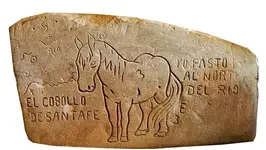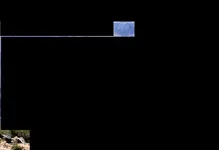The truth behind the stone map story. It was never the Travis Tumlinson story, it was the Phillip Leasman story.
In the late teens of the 20th century (1915 - 1920 ) Peg Leg Tumlinson was living at the old Leasman cabin near Stockdale, Texas. Peg Leg Tumlinson was the grandfather of Travis Tumlinson. Phillip Leasman whose family owned the cabin was the uncle of Travis Tumlinson, his mother’s brother.
For the last few years of Peg Leg Tumlinson’s life, Phillip Leasman was taking care of him, bringing him food, doing chores for him and looking after him. At that cabin in those years, 1915-1920, all of Peg Leg Tumlinson’s things were there with him. Many artifacts, documents, maps, statues and numerous stone carvings were stored there.
Peg Leg Tumlinson died in 1920 and immediately Phillip Leasman moved into the old cabin with all of Peg Leg Tumlinson’s things.
Not long after Peg Leg Tumlinson died and Phillip Leasman moved into the cabin he started bringing his nephew Travis Tumlinson around showing him all the things that had belonged to Peg Leg. Travis became a regular at the old cabin.
It was Phillip Leasman who carved a good many of the pictures on the old stone chimney at the cabin. Over the years many carvings on that chimney and on rocks not far from the cabin were carved on by young people in the Stockdale area. Travis undoubtedly did “some” carving but was just one of many who used the area for their artwork. The chimney contains the initials and pictures of numerous people who carved them there and these people were no relation to any of the Tumlinson’s.
To say exactly who carved which pictures and when they carved them on the chimney and nearby rocks is pure speculation. That is the truth of the matter.
In 1933, Phillip Leasman urged and financed Travis Tumlinson to move to a little shack between Florence Junction and Superior, Arizona. Leasman had found a job for Travis at a mine southeast of Florence Junction along Walnut Canyon wash. Several mine claims there were known as the Walnut Canyon claims and were in some rough country. Travis took a job as a tender of the mules and horses used at the mine. The mines were once a part of the Ray Mines Division and today are a part of the Rio Tinto Corporation.
Travis worked there until sometime in 1937. But it was not the Walnut Canyon mine that Phillip Leasman and Travis Tumlinson were interested in. Leasman had sent his nephew (Travis) to that part of Arizona because it was near the area he wanted Travis to explore, an area just a few miles to the west in the Southeastern Superstition Mountains around Hewitt and Millsite canyons and nearby Queen creek.
Phillip Leasman had gotten information from things Peg Leg Tumlinson had shown and told him when Peg Leg was living at the old cabin. From maps Peg Leg possessed, both stone and paper, he believed there were mines and buried treasure in the area. Leasman traveled to Arizona to stay with his nephew and search the area himself when time allowed.
Travis after marrying and having a child, later found work at Hood River, Oregon but over the years, until Travis Tumlinson’s death in 1961, Phillip Leasman and Travis would make regular trips to the area around Queen creek and the southeast Superstition Mountains searching for specific mines and treasure using these maps.
In the early-mid-1950’s Travis Tumlinson and Phillip Leasman did the exact same thing Leasman had done with Travis 20 years earlier. They convinced a close friend, Clarence Mitchell (Travis Marlowe) to move from nearby Leavenworth, Washington to a little place near Florence Junction along Queen creek to look for a specific set of mines and treasure buried somewhere in the Southeastern parts of the Superstition Mountains.
Mitchell moved his family, wife Grace and daughter Carol to Queen Creek, took a job in Apache Junction and went into the Superstitions every chance he got to search for mines and treasure. Travis Tumlinson and Phillip Leasman visited with Mitchell in Arizona and went in the mountains with him when they could.
When Travis Tumlinson died in 1961, Leasman kept in contact with Mitchell and the two continued to search the Superstition area together. Phillip Leasman was at this time fairly unable to physically search the mountains and Mitchell did the leg work for both of them.
Phillip Leasman died in 1970 and by then Mitchell had moved to Placerville, California where he spent the summers but still wintered in Arizona at Queen Creek and Apache Junction. He continued to search for the mines and treasure Travis and Phillip believed hidden in the Superstitions until he could himself no longer hike the mountains.
What began with Peg Leg Tumlinson and later Phillip Leasman in the old cabin near Stockdale, Texas in 1920 lasted for over a half a century. Who knows for how many years before that Peg Leg Tumlinson may have alone pursued the information of mines and treasure buried somewhere in the Superstitions?





